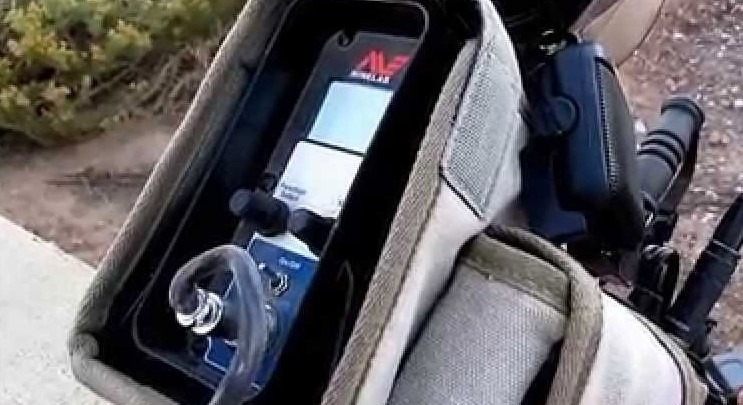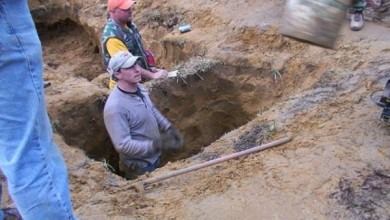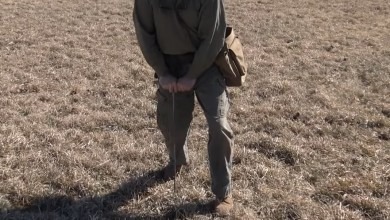TECHTIPS & TRICKS
Why PI Detector at DIV

AUTHOR: Hugh Campbell
Because this question gets asked repeatedly (and rightly so) by many first time and even veteran DIVers, thought I would put together a little Primer on detector technology at DIV from what I have learned about relic hunting specific to the Culpeper general vicinity and DIV in particular. I am not an expert but have tried to keep it factual without a lot of “opinion”. I have only been to a handful of DIVs. I will invariably have written in some typos, mistakes and misconceptions. And of course everyone has their own opinion. So…please critique my writeup, add your own thoughts, have spirited arguments, because this thread is all about learning for the new and old DIVer alike. Also, in accordance with the DIV disclosure rules, I have not intentionally provided any sensitive information that has not been made available on the public forum, to my knowledge.
First some background on Culpeper General Vicinity where many DIV hunts are held:
Culpeper was a main crossroads in Virginia for both rail and wagon and its central Virginia location made it a great staging point for Army of the Potomac CW units to move in any direction to attempt to counter the Army of Northern Virginia (Lee) from Richmond to Gettysburg. There were some local battles in Culpeper including the Battle of Cedar Mountain and the largest cavalry battle of the CW at Brandy Station plus countless other minor skirmishes. The farmlands DIV secures to hunt are chosen because they are located on known CW army unit winter encampments primarily in the 1863-64 time frame (i.e., after Cedar Mountain (1862)/Fredericksburg (1862)/Chancellorsville (1863)/Brandy Station (1863)/Gettysburg (1863) but before the Battle of the Wilderness just east (Spring 1864)).
But the relics found are not just limited to that Winter encampment time frame since troops continually camped, fought, and passed through the area during the entire war based on Culpeper’s strategic location. These areas have been hunted on and off for decades for CW relics. The soil is great for farming but horrible for detecting because the red clay is full of ferrous mineralization that is to radio signals used to detect metal like headlights trying to punch through fog. Also, the fields are littered with iron farm junk (broken pieces of iron farm machinery) and the small square nails which were used to build fences and huts for the camps. These small iron targets are the bane of the DIVer. They can sound great in your headphones and are therefore hard to “brain” discriminate out unless you know the subtle audio cues so you will dig dozens of these things and they can mask legitimate targets should you choose to just ignore them and move on.
While surface finds still exist, they are relatively rare. Veteran DIV hunters are looking for those deep large tones (e.g., barrel bands) that indicate a trash pit or hut from which they can dig down 2 or 3 feet or more and pull out a cache of metal and unbroken glass CW relics. The relics are deep because of decades of relic hunting, farm work, and erosion. There was a renaissance of sorts with the newer technology PI machines in the early 2000’s from which more, deeper “surface” relics were found, but if you do the math DIV 36/37 (now 48 since I first wrote this) is a pretty high number so you can figure these various DIV sites have been hit pretty hard by DIVers and lone wolfs though there are still some less pounded territory (e.g., DIV 36 site).
Pulse Induction Machines: The most effective metal detecting technology for such conditions is called Pulse Induction. Pulse Induction machines will find all the metal in whatever medium (i.e., soil condition) you are searching (beach, underwater, high soil mineralization, and small gold nugget and meteorite hunting). They are not your typical coin shooting machine, nor should they be for many reasons. They are designed primarily for gold prospecting in harsh soil. DIV detectorists have repurposed them for relic hunting and they get the job done. Except for the most expensive machines, they lack discrimination (iron rejection) so if you want to dig up bobby pins and fish sinkers at 3 feet on the beach all day, you may want to stay away unless you really want to find that 3 foot deep gold diamond ring. Also, they tend to be less compact than VLF machines because they have to radiate more power into the ground. The discrimination based machines that will blank out or grunt at large iron and are more expensive but are best suited for the DIV situation because they don’t care about ground mineralization and are DEEP. Deeper than any VLF machine out there under the same soil conditions.
There are still surface targets to be found at DIV, but are relatively rare. They get plowed up to the surface or have just been missed by detectorists over the years (perhaps the button was edge on or under a big piece of iron trash or a coil just never made it over the target). Those surface finds (within about 5-7 inches to the surface) are what the VLF may be able to see in these conditions. VLFs cannot penetrate much more than that because of the soil mineralization unless the target is very large. They can also work in wooded areas where there is less mineralization, but underbrush and acreage limit your opportunity there.
More on VLF below. The three most popular PI machines are the Whites TDI/TDI Pro/TDI SL machines which run used $600 to $1200 new. They are relatively lightweight compared to the other PI’s but lack iron discrimination. They can be set up to search on all metal or just low conductor like brass, so are a known button magnet machine, but you will have trouble telling a bullet from a square nail (see above). TDI is not weatherproof. The next in terms of cost is the Garrett Infinium (no longer manufactured) which you might be able to still find used for closer to $1000, then comes the successor to the Infinium – the mil spec Garrett ATX ($1500 used to $2500 new). Based on a military grade mine sweeper, it folds up compact, is waterproof to 10 feet similar to the AT Pro, and has IRON grunt discrimination, auto frequency tune, and is plenty deep. The main knock against the ATX is its weight. To swing it all day, you really need a harness. It is also a visual/audio machine. You rely on the tones and the led bargraph display of target strength to make the decision to dig. Very easy to set up and go. Not a lot of accessory coil choices. Finally, the gold standard of DIV is the Minelab GPX series (4500/4800/5000) you can spend anywhere from just over $2K to $5K on these machines but there is a reason for their popularity. They can be tweaked to your heart’s content for the soil conditions, they are lighter than the ATX, they have tons of after market coil choices and accessories (compact battery pack vs. the bulky separate battery/amplifier pack Minelab supplies), and they get the job done because they are an audio only machine in which the subtleties in the audio signal help you to “visualize” the characteristics of the target you are swinging over. They are not weatherproof so you have to home brew a bread bag/ziplock bag setup to protect your detector in the rain and the Minelab coils are (notoriously) not waterproof so you need after market (e.g., Coiltek, Detech) waterproof coils to hunt in the rain/snow. Expensive but worth it to those going after the big prizes in the ground and who do it often enough that the “investment” is worth it. Though I don’t know many DIVers who sell their finds to fund their machines, so I use the term “investment” figuratively.
VLF Machines: You will be able to find relics using an AT Pro or any other mid to high range VLF machine that has the ability to compensate for ground conductivity (manual and/or auto ground balancing). A inexpensive but otherwise great coin shooting machine such as the Teknetics Delta will not perform well at all in Culpeper soil because of its high mineralization and the machine’s fixed soil conductivity setting that is set for average soil conditions (that is also why it is also not a good wet sand beach machine). So if you have an entry level VLF machine, it will not work well at all at DIV. Besides the AT Pro, some VLF machines that have worked well at DIV based on what I have seen and read – Whites MXT, Fisher F70/F75, Teknetics T2/G2, Teknetics Patriot Series, AT Pro or AT Gold, XP Deus, even the much maligned Whites MX Sport. The higher operating frequency (usually designated “gold” in their name) vlf machines tend to do better because they penetrate the mineralized soil better and hit harder on the small, mid-conductors (brass, small lead) that comprise most desired relics such as buttons and knapsack hardware. You may not find the deep trash pit or hut with a vlf (but it is still possible) but you can find surface bullets, buttons, buckles, and the occasional plate, corps badge, or id tag that just happens to be within a few inches of the surface and was missed all these years. Also some surface finds can lead to deep huts when you put shovel to soil to recover the target and find charcoal, broken glass, or multiple targets in the hole. If that is the case, then you will want to keep digging and not just recover the primary target.
You need to decide whether it is worth it to invest in a new machine just for DIV. I would think about whether I would use the machine again back home before I make that investment. The DIV favorite machines do have good resale value to DIVers should you go that route and you could possibly pick up a good used machine at a decent price.
Feel free to add on information in followup posts. Thanks.
Amending this post to add some invaluable information from Streak! posted to a DIV private forum regarding a step-by-step method to set up your GPX for quiet stable operation (Thanks Streak! now we have it for perpetuity):


